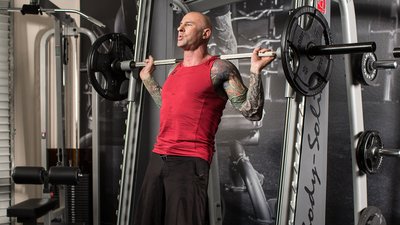Can you imagine being the basketball player who replaced Michael Jordan on the Chicago Bulls? Or Tim Cook, the guy who followed Steve Jobs at Apple? Or the quarterback who will replace Tom Brady when he hangs up his cleats? Talk about big shoes to fill.
You may feel that same sense of incredulity as I discuss leg exercises that are alternatives to squats. Yes, the barbell back squat is the "king of exercises," and I'm as big a fan of the move as anyone. But if you're concerned that squats will increase your risk of injury—or you just flat-out don't like doing them—then don't perform them in the traditional sense.
I do strongly recommend, however, that you include some form of squatting motion in your training program on a regular (at least weekly) basis, as it's a fundamental movement not only in the realm of training and athletics, but in real life as well. I know barbell squats can be tough on your lower back and knees—trust me, I've had back issues myself. But there are many different squatting variations that can relieve the strain on these vulnerable areas yet still provide a stimulus to the glutes, quads, hamstrings, and the rest of the body comparable to putting a barbell on your back and banging out reps.
Below are six such exercises. Plug any one of these moves into your leg routine where "barbell squat" shows up, and you can reap (mostly) the same strength and muscle-building benefits offered by the "king."
Squat Alternative 1: Front Squat
Why It's Sub Worthy: It's still a barbell squat, but the position of the bar on the front of the shoulders makes a huge difference. For one, front squats place a higher proportion of tension on the quads than the glutes compared to back squats, so it's a great exercise for anyone looking to bring up his or her frontal thighs.
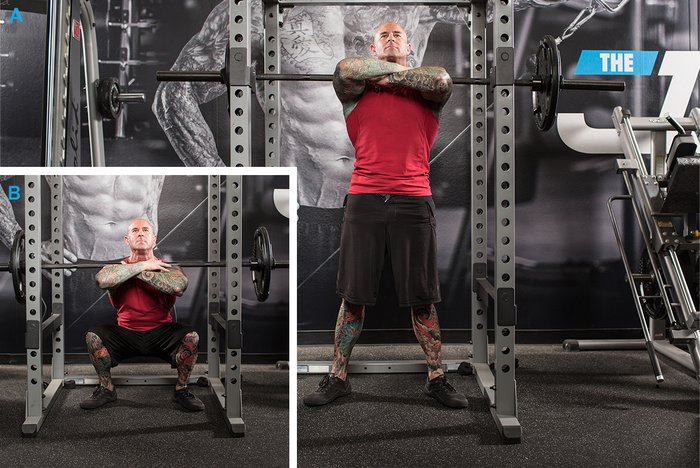
Front Squat
But more important for those with lower-back issues, front squats force the torso to remain more upright than back squats do (otherwise the bar will fall forward and drop to the floor), thus relieving some of the strain on the spine.)
Key Training Tips: Cross your arms over your chest to build a "shelf" for the bar to rest on. Feel free to use a clean/rack grip if that's your preference. Descend to a point at which your thighs are beyond parallel with the floor.
Squat Alternative 2: Jefferson Squat
Why It's Sub Worthy: This exercise is often referred to as the Jefferson "deadlift," but the upright nature of the torso more resembles a squat than a traditional deadlift, where you're forced to lean further forward because the bar is in front of both legs. With this version, you're straddling the bar. That upright torso is the main reason people with bum lower backs prefer the Jefferson.
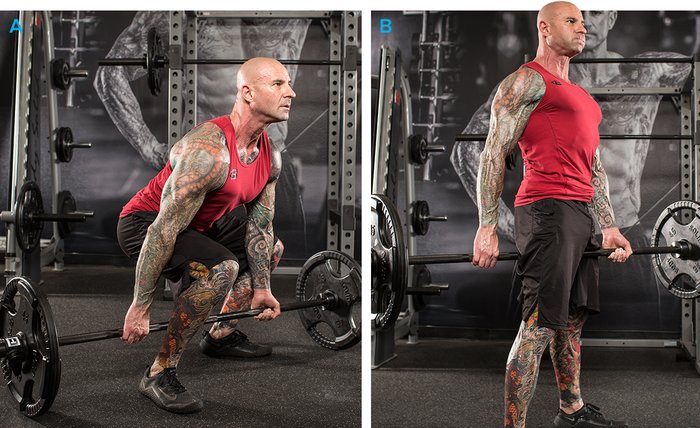
Jefferson Squat
Key Training Tips: Keeping your core tight, chest out, and back flat, stand up with the bar by forcefully extending your hips and knees, pressing through your heels. Reverse the motion, letting your glutes track backward, to lower back down. When your thighs reach parallel or the bar touches the floor, drive up to the standing position.
Squat Alternative 3: Zercher Squat
Why It's Sub Worthy: Zerchers are another great squat variation for taking stress off the lower back. The bar sits significantly lower on the body (at the midsection, not up high on the back), which reduces the compressive forces on the spine considerably. Similar to front squats, Zercher squats require you to maintain a more upright torso, and they also allow you to achieve a greater depth at the bottom.
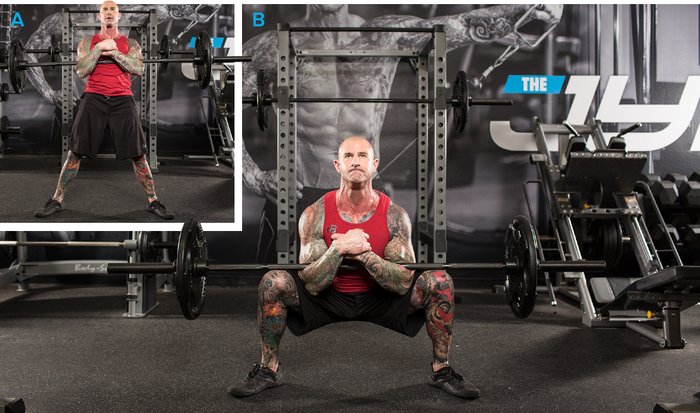
Zercher Squat
Key Training Tips: Rack the bar well below shoulder height in a power rack. Position the bar in the crooks of your elbows with your arms bent at least 90 degrees. Bend at the knees and hips, letting your glutes track backward, to lower yourself into a squat. When your quads reach parallel with the floor, drive up forcefully through your heels to the standing position.
Squat Alternative 4: Single-Leg Barbell Squat (aka Bulgarian Split Squat)
Why It's Sub Worthy: This exercise goes by several different names, perhaps because it's something of a cross between a squat and a lunge—the feet are staggered, with one directly in front of the body and the other directly behind. It's this lunge orientation that allows you to keep your torso perpendicular with the floor and clear from the excessive forward lean that often causes lower-back strain.
Also, keeping one foot behind allows you to plant the front foot as far forward as necessary to keep that front knee safe from undue stress. With this movement, you have the option of either putting a barbell on your back or holding dumbbells.
Key Training Tips: If you're holding dumbbells, you may be limited by your grip strength; in that case, use the barbell version. Bend your forward knee and hip to lower your body until your same-side thigh is parallel with the floor. Reverse the direction, driving up forcefully through the forward heel to the start position, using the back foot for balance.
Squat Alternative 5: Smith Machine Squat
Why It's Sub Worthy: Anyone who bashes the Smith machine for not being "functional" hasn't opened up his or her mind to all the function this training tool has to offer. Where squats are concerned, the Smith machine offers a couple of great benefits in particular:
- It allows you to safely overload the lower-body muscles with heavy weight to spark new gains in both size and strength, because you don't have to worry about keeping your balance.
- It lets you adjust your foot position to target different areas of your legs. For example, placing your feet further forward (something you can't do with a barbell) targets the glutes for those who want to emphasize that area.
This forward foot position also reduces your shin angle, which takes pressure off your knees. Think of it the same way you would lunges, where taking a larger step forward keeps your knees from tracking over your toes.
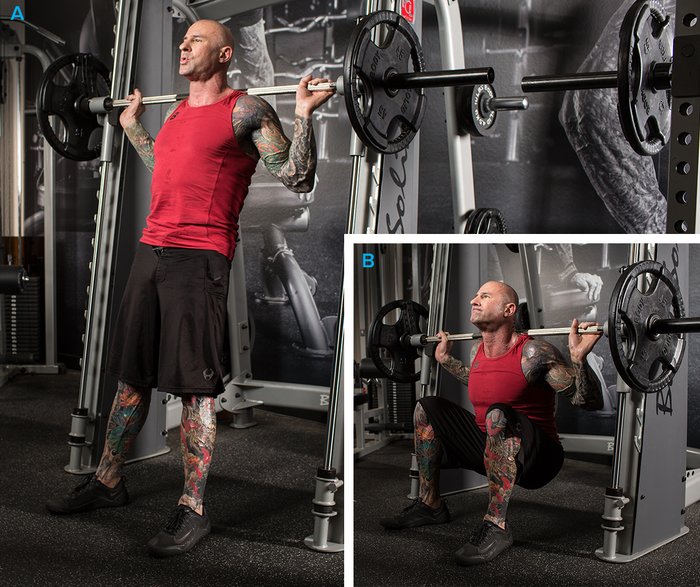
Smith Machine Squat
Key Training Tips: This is an especially good choice when you do squats later in your leg workout (which you might do when you want to go lighter, as the legs will already be prefatigued). When using an angled machine rather than one in which the bar strictly travels straight up and down, always stand inside the unit, and face outward to better match the natural arc of the bar.
Squat Alternative 6: Barbell Hack Squat
Why It's Sub Worthy: At first glance, this exercise may look a bit odd, like you're doing a deadlift the wrong way, because the bar is behind your legs instead of in front. But this is by design; in fact, the barbell hack squat has been around for many decades, a lot longer than the hack-squat machine you see at most commercial gyms today.
This move is unique because the weight is behind you, and there's less strain placed on the lower back compared to a standard deadlift because you're not forced to lean so far forward. This version makes it much easier to keep your weight back over your heels, which is where you'd want it be when doing a regular barbell squat. This is a key benefit for anyone with lower-back issues.
Key Training Tips: Your palms can either be both facing forward or staggered so that one faces forward and the other back—whatever you prefer. Keep your back flat (not rounded) and your spine in a neutral position on both the positive and negative portions of each rep.
For more training programs, as well as nutrition and supplement articles to complement them, check out jimstoppani.com.

